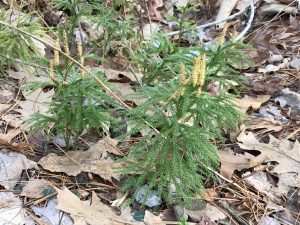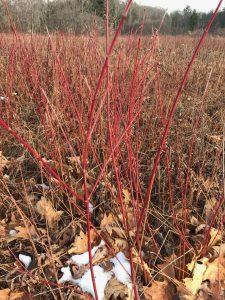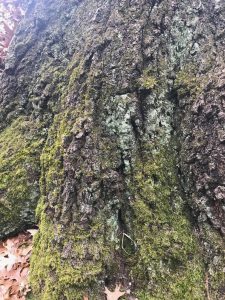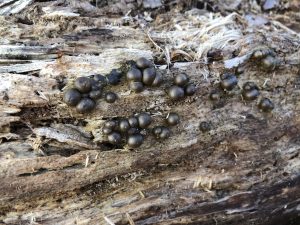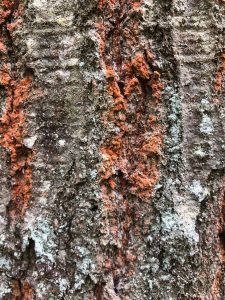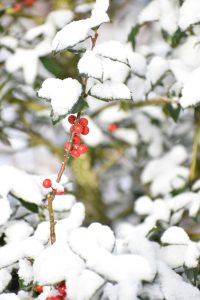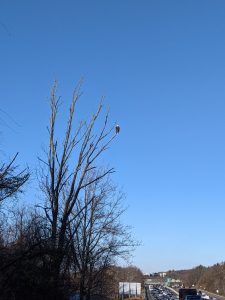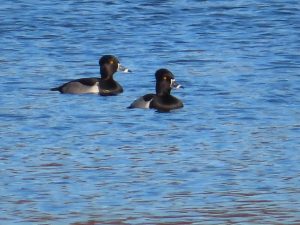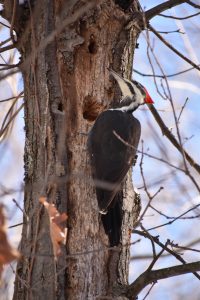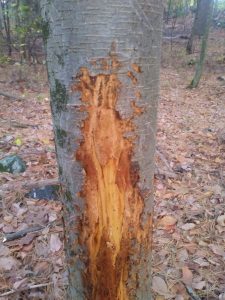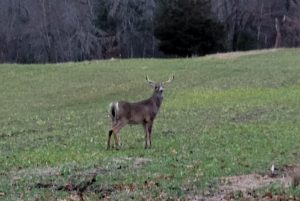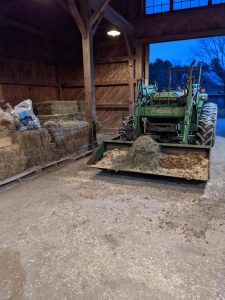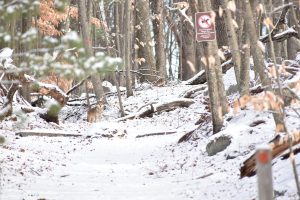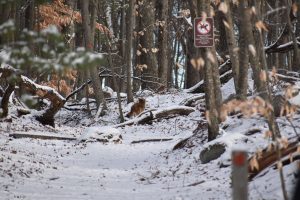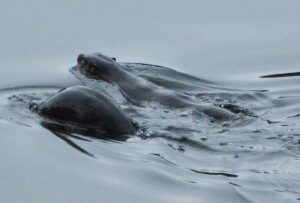Written by Gwyn Loud for the Lincoln Land Conservation Trust. She welcomes your sightings and questions at 781-259-8690 of gwynloud555@gmail.com
The weather over the past month has vacillated between unusually warm (e.g. 60℉ on Dec. 3) and very cold, causing a skim of ice on ponds. Looking back at December columns for recent years, this weather pattern seems the norm. We have also had welcome days of rain, with the result that Middlesex County is now in the lowest level of drought, “Abnormally Dry.” A dusting of snow fell overnight on Dec. 11, not enough to bring out the plows but enough to paint the landscape a beautiful white. We shall welcome winter officially on Dec. 21, the solstice, the shortest day of the year in the Northern Hemisphere. Thereafter, the hours of daylight will slowly lengthen, prompting some birds such as the black-capped chickadee, to start singing breeding calls even in early January.
Vegetation, except for lawns, is now primarily brown and gray, but there is still plenty to observe on a walk in the woods. Club mosses, for instance, are green all winter, looking like miniature conifers on the forest floor. They are a group of ancient plants which do not have flowers or fruits and reproduce by spores rather than seeds. Lichens, mosses and fungi offer arrays of shapes and colors, as do forms of slime molds and algae. The beautiful red stems of red osier dogwood, the most widespread native species of dogwood in the U.S.A., can be found in open shrubby wetlands. And don’t overlook hardy dandelions: they seem eager to flower in sunny grassy spots anytime. I have snowdrops already blooming next to the east wall of my house!
In the avian world, late migrants are still being reported, perhaps due to the spells of warm weather. At Drumlin Farm, for example, a Wilson’s warbler, yellow-rumped warbler, and parula warbler were seen into December, and fox sparrows and hermit thrushes were also recorded. Thirty bluebirds were counted on Dec. 4; they, like many robins, may stay here through the winter. After a hiatus during the pandemic, the saw-whet owl banding program at Drumlin has resumed. Saw-whets, our smallest eastern owls, are late fall migrants but much remains to be known about exactly where they go. Tiny radio transmitters attached to them should help us learn more.
Elsewhere in town, observers noted lingering swamp sparrows and two Virginia rails. Bald eagles and common ravens, once uncommon, are now seen regularly. A surprising early arrival from the north was a flock of snow buntings on the Ricci Fields, and several irruptives such as pine siskins, evening grosbeaks, and purple finches have turned up at feeders.
How do our winter birds survive bitter cold temperatures? They have adaptations. For starters, they can lower their metabolism involuntary at night and then most seek protection by sheltering in evergreens or protected spots. From a Mass Audubon newsletter, “Birds that overwinter in cold climates grow additional feathers when the cold sets in and will fluff them up to create air pockets that increase insulation by trapping heat. A few species, like Eastern Bluebirds, will huddle together to further reduce heat loss.” Birds hurry to feed when morning comes, needing energy to maintain their body temperature of about 105℉ during the day.
Three species of gulls were seen on Flint’s Pond in mid-November: 65 herring, five ring-billed, and one Iceland. Since then ducks have been there in large numbers, including 102 common mergansers as well as several bufflehead, common golden-eye, hooded mergansers and a single long-tailed duck. A lone horned grebe was an usual sighting. On Beaver Pond, Vin Durso, from a canoe, observed ruddy ducks, and a number of ring-necked, but one was off by itself for a long time. Vin, approaching the bird, wrote that the poor duck “had lassoed himself around the neck with fishing line- probably when feeding.” Vin called his wife, Suzette, for help and, thankfully, they managed to get the duck untangled.
The annual Christmas Bird Count is organized all over the country by the National Audubon Society within a two-week window. The data collected gives valuable information about population numbers of species and their range and the impacts of climate change and other factors. Lincoln is part of the Concord Bird Count and our date is Jan. 1 this year. Townspeople who would like information about participating either as part of a field team or counting birds at feeders should check the website: https://concordcbc.org or call Norman Levey at 781-259-0855 or contact me.
We continue to see numerous mammals all winter. Many people have reported bucks, as this is towards the end of rutting season, when deer mate. You may come across rutting scrapes or rubs on trees. These are places where bucks leave their scent by scraping their antlers against the bark and thereby communicating territorial bounds old and readiness to breed.
A resident abutting Farrar Pond saw otters swimming on a bitter cold day, making me wonder how they keep warm. Research revealed that otters, which are members of the weasel family, rely on their hair, as they do not build up a thick layer of fat, like most mammals in winter. According to an AP article, “ the otters’ fur has long strong outer hairs – called guard hairs. The guard hairs are hollow and have scales, almost like a snake’s scales. They help keep densely packed finer hairs – called underfur – dry. The underfur has a scaly surface also, which helps them lock together to keep out water. The otter’s hairs are also very oily, which makes water slide off instead of soak in. The oil comes from a gland next to the base of the hair in the otter’s skin. They can also fluff up their fur when they get out of the water to trap air between the hairs. The trapped air can help insulate them from the cold, as well.” Sometimes otters take shelter in an old beaver lodge for protection from the cold.
As this is my final wildlife column of 2022 I would like to take the opportunity to thank my “official team” of wildlife observers: Ryan Brown, Stacy Carter, Vin Durso, Marcia Gagney, Michele Grzenda, Nancy Hammond, Sue Klem, Jane Layton, Will Leona, Norman Levey, Kathleen Lomatowski, Ron McAdow, Harold McAleer, Ellen Meadors, Alaric Naiman, Corey Nimmer, Tia Pinney, Carol Roede, Nancy Soulette, Pam Sowizral, Rob Todd, and Robin Wilkerson. I am also grateful for the calls and e-mails from other observant townspeople who appreciate the many forms of wildlife around us. Thanks go as well to Miranda Loud for proofreading and to Bryn Gingrich who puts the column on the LLCT website, along with photos.
I wish all readers a happy holiday season, with ongoing enjoyment of the natural wonders around us in 2023.
2020 Online Program with John Calabria on Animals in Winter
2020 Online Program with Gwyn Loud and Ron McAdow on Bird Feeding in Winter (and Year Round)


